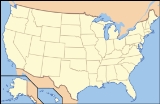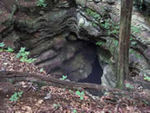
Fern Cave National Wildlife Refuge
Encyclopedia

Fern Cave National Wildlife Refuge is a 199 acre (0.80532514 km²) National Wildlife Refuge
National Wildlife Refuge
National Wildlife Refuge is a designation for certain protected areas of the United States managed by the United States Fish and Wildlife Service. The National Wildlife Refuge System is the world's premiere system of public lands and waters set aside to conserve America's fish, wildlife and plants...
located in northeastern Alabama
Alabama
Alabama is a state located in the southeastern region of the United States. It is bordered by Tennessee to the north, Georgia to the east, Florida and the Gulf of Mexico to the south, and Mississippi to the west. Alabama ranks 30th in total land area and ranks second in the size of its inland...
, near Paint Rock, Alabama
Paint Rock, Alabama
Paint Rock is a town in Jackson County, Alabama, United States, along the Paint Rock River, and is included in the Huntsville-Decatur Combined Statistical Area. As of the 2000 census, the population of the town is 185....
in Jackson County
Jackson County, Alabama
Jackson County is a county of the U.S. state of Alabama. Its name is in honor of Andrew Jackson, general in the United States Army and President of the United States of America. As of 2010, the population was 53,227. The county seat is Scottsboro. Jackson County is a prohibition or dry county,...
.
More than 1,200 visitors per year visit the refuge. The facility is unstaffed, but is administered by the Wheeler National Wildlife Refuge
Wheeler National Wildlife Refuge
The Wheeler National Wildlife Refuge is a 35,000 acre National Wildlife Refuge located along the Tennessee River near Decatur, Alabama...
in Decatur, Alabama
Decatur, Alabama
Decatur is a city in Limestone and Morgan Counties in the U.S. state of Alabama. The city, affectionately known as "The River City", is located in Northern Alabama on the banks of Wheeler Lake, along the Tennessee River. It is the largest city and county seat of Morgan County...
. The cave itself is closed to the public.
Topography
Most of the Fern Cave NWR is on the western side of Nat Mountain between ScottsboroScottsboro, Alabama
Scottsboro is a city in Jackson County, Alabama, United States. As of the 2010 census, the population of the city is 14,770. Named for its founder Robert Scott, the city is the county seat of Jackson County....
and Huntsville, Alabama
Huntsville, Alabama
Huntsville is a city located primarily in Madison County in the central part of the far northern region of the U.S. state of Alabama. Huntsville is the county seat of Madison County. The city extends west into neighboring Limestone County. Huntsville's population was 180,105 as of the 2010 Census....
. The Paint Rock River
Paint Rock River
The Paint Rock River is a tributary of the Tennessee River in northern Alabama in the United States. Its tributaries also drain a portion of south-central Tennessee....
, a tributary of the Tennessee River
Tennessee River
The Tennessee River is the largest tributary of the Ohio River. It is approximately 652 miles long and is located in the southeastern United States in the Tennessee Valley. The river was once popularly known as the Cherokee River, among other names...
borders the northwestern side of the refuge. Elevation ranges from the relative flat area around the Paint Rock River valley to a 1,500+ foot elevation at the top of the mountain.
Fern Cave

Hart's-tongue fern
Asplenium scolopendrium, Hart's-tongue Fern is a fern in the genus Asplenium, of the Northern Hemisphere.-Distribution:...
(Phyllitis scolopendrium). The fern population has disappeared since 1985 from a high of twenty due to the actions of illegal plant collectors.
Fern Cave itself is described as a "vertical and horizontal maze". There are 12 different levels connected by canyons and pits. The cave is approximately 15 miles (24.1 km) long and and cave system is 450 feet (137.2 m) deep. The cave remains very inaccessible. At least one experienced spelunker
Spelunker
Spelunker has several meanings.* In Caving, "spelunker" is sometimes a term for a person who explores caves.* Spelunker , a 1983 video game for various systems, including Atari and Nintendo....
has died in the cave.
There are five entrances to the cave although only four of them are within the Fern Cave NWR. The fifth entrance is owned by the Southeastern Cave Conservancy.
Wildlife
Fern Cave serves as a home to the largest colony of federally endangered gray batGray Bat
Myotis grisescens once flourished in caves all over the southeastern United States, but due to human disturbance, Gray Bat populations declined severely during the early and mid portion of the 20th century. At one cave alone, the Georgetown Cave in Northwestern Alabama, populations declined from...
s in the United States. NWR officials estimate that over 1.5 million gray bats use the cave annually.
Approximately 200 species of animals use the refuge. Other than the endangered bats, the cave contains cave fish (Typhlichthys subterraneus
Typhlichthys subterraneus
Typhlichthys subterraneus is a species of fish in the Amblyopsidae family. It is endemic to karst regions of the eastern United States.-Taxonomy:...
), cave crayfish, banded sculpins, cave salamander
Cave salamander
The Spotted-tail Salamander is a species of cave salamander.-Distribution:This species is found in Illinois, Missouri, Kentucky, Virginia, West Virginia, Oklahoma and Kansas.-Identification:...
s (Eurycea lucifuga), and northern slimy salamanders (Plethodon glutinosus
Plethodon glutinosus
The Northern Slimy Salamander is a species of terrestrial plethodontid salamander found through much of the eastern two thirds of the United States, from New York, west to Illinois, south to Texas, and east to Florida, with an isolated population in southern New Hampshire...
). Other animals on the refuge include (Cottus carolinae
Cottus carolinae
Introduction=Cottus carolinae, or the Banded Sculpin, is a freshwater fish dwelling mostly in small to moderate sized streams in areas of swift current. Young and juvenile C. carolinae fish can mainly be found in pools, riffles, and other shallow habitats while adult Cottus carolinae tend to prefer...
), bluegill
Bluegill
The Bluegill is a species of freshwater fish sometimes referred to as bream, brim, or copper nose. It is a member of the sunfish family Centrarchidae of the order Perciformes.-Range and distribution:...
(Lepomis macrochirus), yellow bullhead catfish (Ictalurus natalis), . Outside of the cave, white-tailed deer
White-tailed Deer
The white-tailed deer , also known as the Virginia deer or simply as the whitetail, is a medium-sized deer native to the United States , Canada, Mexico, Central America, and South America as far south as Peru...
, turkey
Turkey
Turkey , known officially as the Republic of Turkey , is a Eurasian country located in Western Asia and in East Thrace in Southeastern Europe...
s, squirrel
Squirrel
Squirrels belong to a large family of small or medium-sized rodents called the Sciuridae. The family includes tree squirrels, ground squirrels, chipmunks, marmots , flying squirrels, and prairie dogs. Squirrels are indigenous to the Americas, Eurasia, and Africa and have been introduced to Australia...
s, opossums, raccoon
Raccoon
Procyon is a genus of nocturnal mammals, comprising three species commonly known as raccoons, in the family Procyonidae. The most familiar species, the common raccoon , is often known simply as "the" raccoon, as the two other raccoon species in the genus are native only to the tropics and are...
s, and rabbit
Rabbit
Rabbits are small mammals in the family Leporidae of the order Lagomorpha, found in several parts of the world...
s.
Facilities

Even through the bats leave the cave nightly for food, the refuge recommends against viewing the emergence. The area around the cave entrances is steep and potential dangerous in the dark. Thus, the park closes around dusk.
Otherwise, there are opportunities for hiking, photography, and wildlife observation at the refuge.

